If you’re just tuning in to this series on insulin resistance, here’s a little recap: In Part 1 of the series, I introduced you to my current diagnosis of *almost* insulin resistance. This was a big shock to me and not at all what I expected to hear at my last check up. In Part 2 of the series, I explained just what exactly insulin resistance is and how it relates to pre-diabetes and Type 2 Diabetes. That post got a little heavy on the science, but if you like that sort of thing, it’s a must read.

Today we get into my action plan. Disclaimer: This is my action plan, based on recommendations from my functional medicine doctor, based on all that he knows about me from lots of blood work, genetic testing and face-to-face appointments. I am not in anyway suggesting that you follow this same plan.
All that being said, aside from the supplements, what I’m doing to get a handle on this condition of being almost insulin resistant is just good, common sense. Nothing extreme or bizarre here and it is my opinion that most people would benefit from implementing some of these changes in their own lives.
I will tell you which supplements I’m taking, but I don’t recommend you rush right out and buy any of them. What I do suggest you do is see your doctor if you have concerns about whether or not you are on this pathway to Diabetes.
I currently take one mild prescription medicine which is aimed at keeping my Crohn’s disease in remission. This is an off-label use, but one my doctor feels is a good choice. You can read more about it here in this article from Chris Kresser. In addition to this one prescription, I take a lot of supplements. So many in fact, that it’s a burden, to be quite honest. Each one is specifically targeted at some aspect of my current condition(s) and many of them work in synergy, which is why I am taking so many. My hope, which I have expressed to my physician, is that I can drop many of these in the near future.
What follows is a journal of sorts beginning with my thoughts immediately following this diagnosis and proceeding to the present.
What exactly am I doing about my *Almost* Insulin Resistance?
January 27th: I’ve just met with my functional medicine doctor, where I learned that my latest blood tests indicate that I am almost insulin resistant. (There is a scale of sorts that is made up of several different lab tests and my score puts me one point shy of what the experts consider insulin resistant.) I’m shocked, but I’m determined to reverse these results. I have ordered the new supplements my doctor prescribed and I bought lots and lots of vegetables. I also checked out the following book from the library because it fits very well with this plan I should be following:
Dr. Hyman’s Blood Sugar Solution and
According to my doctor (my functional medicine doctor, whom I will call Dr. C), the basic plan for getting out of this condition is eating lots of vegetables and very little to no sugar. Protein and fats are a-okay. And then, hopefully, everything will go back to normal. If not, we’ll look at changing some of my supplementation again.
Dr. C recommended that I keep my carbohydrate intake to 100 grams per day or less or up to 150 grams on heavy exercise days. And I can’t just eat any carbs. I need almost exclusively cellular carbs. There are two types of carbohydrates: cellular and acellular, defined as follows:
Cellular carbohydrates are those carbs where the cell walls/membranes are intact. Think whole fruits and vegetables.
Acellular carbohydrates are those where the cell walls/membranes are no longer intact. This includes anything processed, even a fruit and veggie smoothie would fall into this category because by blending all those healthy veggies into a smoothie, you have broken down the cell walls and that is not ideal. You want your body to do that work, not the blender.
On top of focusing on cellular vs. acellular carbs, I need to aim to eat 25 different types of cellular carbs every few days. Do you regularly eat 25 different types of vegetables every couple of days? I don’t and I eat a lot of vegetables. I probably eat 10-12 types of veggies a week. Twenty five will be a challenge. But I’m up to it. I explained all this to my kids and my son in particular, loves to count the types of carbs in our dinner. Very helpful. Expect when it’s not. Then it’s irritating.
Note from April 9th: I just heard a podcast interview with Dr. Terry Wahls and she recommends you aim to eat 200 plant species in a year. Every herb, leaf, fruit, tea, etc. counts. When you consider all the different types of plants you consume, this seems really manageable.
In summary, these were all the instructions I received at the end of my doctor’s visit in January:
- limit carbohydrates to 150 grams/day max (or just 100 if no exercise)
- carbohydrate intake needs to come from cellular carbs almost exclusively
- little to no sugar
- take prescribed supplements*
- try to get 25 different types of cellular carbs every few days
The unfortunate thing about being an adult is that following these instructions is entirely my responsibility. Even my husband, who is very supportive, cannot make me follow these instructions. In fact, he does make my job a little harder with his own sweets habit. Dear husband: when you eat ice cream and chocolate in front of me, it is difficult. It’s not like this diagnosis makes me dislike sweets.
*The supplements I’m taking are listed below according to the reason for taking them:
- Gut/Crohns
- Ferrochel – Iron
- LDN – Low Dose Naltrexone (this is essentially a very, very low dose of Narcan, what they give in the ER if someone come in with an overdose). It is being studied for interesting new uses in autoimmune disease management.
- Floramyces and ProbioMax Daily – re-balance gut flora
- Calcium D-Glucarate -for high Beta Glucuronidase
- GI Revive, Digestzymes as needed, usually taken with a high fat meal (I do not have a gall bladder so sometimes need some digestive help. Generally, a little water with apple cider vinegar works fine.)
- Dyslipidemia – lipids not in ideal size/numbers – See this article for more information on this topic.
- Red Yeast Rice
- Berberine
- Niacin CRT
- Dysglycemia – fasting blood glucose and insulin too high
- Continue Paleo Diet, no acellular carbs. Keep carbs to 100g on resting days, up to 200g on heavy workout days. – This is what was in my follow-up note. In person, he said 150 g on heavy workout days.
- Metabolic Synergy multivitamin
- Berberine
- Inflammation – of the inflammatory markers tested, they were all high. When all else is well, if these markers are high, we assume it’s because of the arthritis in my feet. But now, with lipids and sugars out of whack, these inflammatory markers could mean lots of things, including cardiovascular disease.
- Continue Berberine, Red Yeast Rice
- Continue twice daily CurcuPlex-95 – curcumin supplement
- Continue LDN
- TriFolamin – B vitamins
- Miscellaneous
- Nordic Naturals Fish Oil Take 2 Teaspoons daily on days I don’t eat fish.
-
- HistDAO Capsules: Take 1 or 2 capsules 15min before histamine rich meal IF NEEDED. Breaks down histamine in gut only.
February 1st: I’m using the My Fitness Pal free app to track my food intake for a few days to make sure I am on track with my carb count goal. Keeping a log of every single thing I eat every single day doesn’t work well for me. It makes me think about food all the time. Well, more than normal and that isn’t healthy – for me.
If you have never tracked your food intake or kept any sort of food diary, I recommend you do it for at least three days, one weekend day and two weekdays, to get a feel for your macro breakdown. My Fitness Pal is easy to use and will tell you exactly how many grams of carbohydrate, fat and protein you are consuming (those are the macros or macronutrients).
The vast majority of Americans eat way too many carbohydrates and way too little fiber and protein. If you love fruit and feel like that’s always a good choice, be aware that fruit is all carbohydrate with a little fiber and vitamins thrown in. Yes, fruit can be good for you, but you need more vegetables and more protein than fruits. Don’t even get me started on fruit juice. Just look at these carb counts of common healthy foods. Think about these numbers in the context of trying to keep to 100 grams/day of carbohydrate or less.
1 medium apple has 22 grams of carbs
1 medium ripe banana has 31 grams of carbs
1 cup of grapes has 16 grams of carbs
even a cup of baby carrots, the vegetable too many of us choose, has 12 grams of carbs
your average protein/energy/meal replacement bar has 35-55 grams of carbs
I always keep this in mind when I’m planning my meals. Frankly, I’d rather have an occasional piece of chocolate and skip the fruit. Does that sound scandalous? If you don’t eat much sugar, fruit will start to taste exceedingly sweet. I think that’s why I don’t care for it much. I’m more of a savory person anyway, but when I do want something sweet, I want just a little sweet. A good piece of quality dark chocolate will have less than 5 grams of sugar. And ALL the health experts now agree that dark chocolate is good for you, so this is still a healthy choice. 🙂 I’m serious. The catch is that you can’t just take out the fruit and add in chocolate if you’re not also eating a lot of other plant matter. I do eat a lot of vegetables, so this works for me.
After tracking my food intake for a few days, I’m doing well with keeping my carb intake to less than 100 grams per day – and that is with exercise. I find it pretty easy to add fat to my meals and fat is more satiating than carbs. I think if I loved fruit, this would be harder. Either way, I’d have to eliminate the added sugar and the sweet treats. When I tracked my food intake, I averaged 43 grams of carbs per day and felt fine. My total calorie intake was between 1500 and 1700 per day. I exercised every day I tracked my food so this is about right for me. I should note that I don’t drink anything sweet so I don’t track my beverages, just water, coffee and tea- unsweetened.
February 19, 2017: Just about one month after my initial diagnosis of almost insulin resistance, I feel exactly the same. Of course, I wasn’t feeling at all unwell when I received the diagnosis. I’m very aware of what I’m eating and I am not treating myself much at all. It’s protein, fat and vegetables for me, almost exclusively.
The one change I noticed is that I was not sleeping well. I am typically a very sound sleeper. When I go to bed, I read for 10-15 minutes, turn my light out and I’m asleep. My alarm goes off at 6:30 and I can get up without much trouble.
I did a little research and some schools of thought suggest that the dopamine affect of carbohydrate intake can aid in sleep, so I decided to aim to eat 10-20 grams of carbs closer to bedtime, around 8:00 PM. This seemed to work. Unfortunately, this is just one more thing to think about. I need to assess my dinner and if it was very low in carbohydrates, which it usually is, I need a little carb hit later in the evening. I hope this is not affecting my insulin levels significantly.
There is a companion article I’m working on that will give more details on my eating plan so I won’t go into great detail about that here. I continue to exercise most days of the week. My doctor recommended that I reduce the frequency and intensity of my exercise, which has been the hardest thing for me. I love my interval workouts at the YMCA. Exercise time is me time. I usually workout with a friend, which brightens my day. I get distracted from my day to day life. I get sweaty and all those things make for a happy mama. I knew I would not be able to tone down the exercise dramatically, so for now, I have removed one intense workout and replaced that with a walk, when weather permits. That leaves 4 intense cardio/weight workouts per week and one weight lifting workout. Weekends are for playing with the kids, bike rides, hikes, just generally enjoying the great outdoors.
So have I toned down my workout routine? Not extensively, but considering the benefits of exercise to insulin resistance, and what it does for me over all, mentally and physically, I’m not willing to budge on this a lot.
I thought I’d give you a couple sample menus just to give you an idea of what I’m eating.
Breakfast: either bulletproof coffee (coffee + collagen powder + grass-fed butter + MCT oil) or high protein/low carb pancakes with chicken sausage or eggs
Lunch: lettuce wraps with turkey, a couple apple slices or a big salad with lots of veggies, turkey, avocado, nuts and creamy dressing with homemade mayo (I know stevia is controversial, but I do use it a little. I love “honey mustard” dressing made with this homemade mayo + yellow mustard + a couple drops of liquid stevia.) Right now while I’m focusing on really limiting my sugar, I’m using stevia more than I would normally. I do use a pure version, not one mixed with sugar alcohols.
Dinner: soup with lots of gelatinous bone broth, meat and veggies or slow roasted meat with veggies on the side and white rice cooked in broth. Really, our dinners vary a lot, but it’s always pastured meat, at least two vegetables and sometimes a starch like sweet potato or rice. I only have the starch if I’ve had a hard workout that day and have not already eaten all my carbs for the day.
A couple meals I’m loving right now:
Pork and Veggie Un-Rolls (this is link to the YouTube video of me preparing this dish). Here’s the recipe.
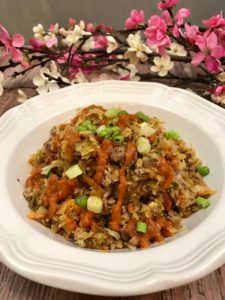
Carnitas with all the trimmings
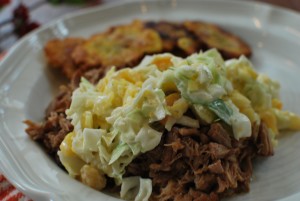
Cheeseburger pie – To give credit where credit is due, this is a Trim Healthy Mama recipe. Of course I made changes. My version has a little less dairy and I added a bunch of veggies to the ground beef part – really, really good stuff. In my recipe, I also give modifications to keep it Paleo.
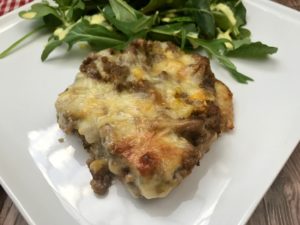
creamy chicken and rice soup – I have a recipe for this in the works, but basically just chicken breast, broth, veggies and rice, simple and nourishing. The creamy part comes from a full head of cauliflower boiled in the the broth and then blended. It’s pretty amazing.
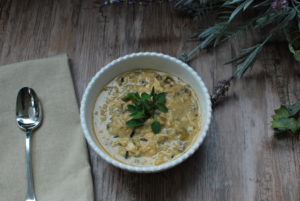
One month in and my weight remains unchanged. I was hopeful that the real concerted control of carbohydrate consumption would get the scale to start budging, but it has not. When your body is in a state of high circulating insulin, it can make it hard for the pounds to drop off. I don’t know how long the weight loss switch stays suppressed when your circulating glucose and insulin levels have been high. Just like everything else in life, we expect immediate results. I’m having to look at this as a lifestyle and not a quick fix or a diet because it certainly won’t be quick.
March 20, 2017: A friend recently told me about a book called the Trim Healthy Mama Plan (THM), which is a weight loss plan with the intention that it will become a lifestyle and not just a diet. The premise of this plan is that all meals are anchored by protein and in addition, you eat either carbohydrate or fat, but not both in the same meal. If you eat carbs and fat together, your body will burn the carbs and store the fat. If you eat those two macronutrients separately, your body will burn the fuel, rather than store it, assuming you don’t eat too much at any one time.
Both Trim Healthy Mama (THM) and Paleo are in essence whole foods diets and do not encourage calorie counting. However, paleo doesn’t separate fuels in the way THM does. THM calls meals with fat and carbohydrates crossovers. If you eat a lot of crossovers, you will have a much harder time losing weight. A lot of paleo meals are crossovers. So I’ve been trying to work through my family’s favorite recipes and see how I can adjust them to fit the THM guidelines and eliminate crossovers.
Another way THM is similar to Paleo, at least as I am following it now, is that you do not eat sugar. Really anything is on the table except sugar. THM recommends their own sugar substitutes that are combinations of sugar alcohols and stevia. I prefer to use pure stevia only.
This THM plan has been a God-send for me because it has allowed me to enjoy some desserts again. I just read an article recently that explained that 80% of the population tastes stevia as bitter either entirely or as an aftertaste, meaning that only 20% of folks don’t taste any bitterness. Thankfully, I fall in that 20%. So do my husband and children. Consequently, I’ve been doing some experimental baking with stevia and so far the results have been pretty good. One of these treats was actually amazing: a key lime cheesecake.This would make a great addition to your Easter feast. Here’s a picture to get your mouth watering.
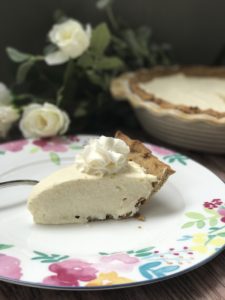
I don’t know if following the THM plan has helped my body physically, but it has sure helped mentally. I don’t feel deprived anymore. When I want something sweet, I can make something with a little stevia and it’s very satisfying. One thing I love about the THM cookbook is that there are a lot of single serving recipes. They even have one for white cake with buttercream frosting. Shameful confession: the white birthday cake with white icing from grocery stores is probably my favorite cake. I haven’t had it in many years, but I can still taste it! So to have an acceptable version that I can make in a short amount of time and eat guilt free, well, that’s worth the price of the book alone.
What’s next? I meet with my doctor again in May. My hope is that all my lab results are back to being well within the normal range by then. I’m also hoping that my extra pounds will have fallen off and left the building.
What I am not doing right now is a sugar detox. Well, I am I guess, as I will be keeping to 100 grams of carbohydrates a day, max, and they will be coming from almost exclusively cellular sources. As you can see from the carb content of common foods listed above, it’s really easy to get to 100 grams of carbohydrate each day.
BUT, I will have a treat on occasion. I will not go off the deep end, but if I have a date with my husband, I might order dessert. If we go on vacation, I will likely eat ice cream. I will occasionally have a good piece of dark chocolate. What this is for me is a lifestyle adjustment. I won’t say change, because switching from the standard American diet to Paleo was a change. This is just an adjustment to what I have already been doing. A getting back on track. Thankfully, it’s spring now and I don’t have to deal with Thanksgiving and Christmas just yet. That will be tough.
April 2, 2017: My husband is a Type I Diabetic. That’s the kind of diabetes that is the result of the body attacking itself (an autoimmune response), where the end result is that the insulin-producing cells in the pancreas no longer produce insulin. Because of his condition, we have glucose monitoring equipment handy at all times. Somewhat hesitantly, I asked him to check my fasting blood glucose one morning as soon as I woke up. A normal reading for someone without diabetes is anything below 100. If you read enough articles, you can find conflicting information on this, but this is the most widely accepted guideline. My fasting blood glucose was 75. That’s great news! It makes me feel like I’m on track. I realize that my LipoProfile results will be as telling, if not more so, than the fasting glucose, but this is something I can track now and it gives me some assurance that things are headed in the right direction.
I see my functional medicine doctor again in early May and I look forward to writing an update to this post in a month or so with good news to share.
If you have questions, ask away in the comments and I’ll get back to you.
Part 4 of this series will be a food diary only, for those of you who really want lots and lots of details about how I’m eating. Except for the recipes I’m still working on writing up, what we eat can all be found here on the blog. I don’t just post recipes to get attention and fame (ha ha!). These really are the foods we eat. I’m slowly working my way through our favorites to determine if I can figure out how to make them work with the Trim Healthy Mama Plan. I’ve added THM categories so you can search by that term now as well.
Part 5 of the series will be the big reveal, posted after my follow-up appointment in May. It will be full of great news, I’m sure! The power of positive thinking and all that.
I read part one and felt like I was reading my own story. Just received the results of my NMR and saw my insulin resistance markers moving to yellow. I’d been fighting lipids for years, this was a new beast for me. Was researching that CHO 15% of calories. Is that what you are doing? I have not met with my True Health coach yet. Can’t wait to discuss findings. You mentioned Mark Hyman. He focuses a lot on fiber. Have you added fiber supplementation? If so, what form are you taking?
On average, I’m staying between 5 and 10% of calories from carbs. I know my fasting glucose is fine, so I’m anxious to see what the NMR shows. I found one of my NMR reports from when I worked for LipoScience 15 years ago and the profile was very similar so I’m really wondering how much of this is genetic. My diet was incredibly different at the time. I’m not taking a fiber supplement just because I’m taking so many other supplements and my functional med doc didn’t suggest it. I just eat a lot of fiber-rich vegetables. I wish you the best!